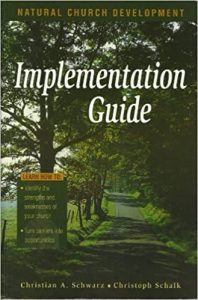by Lim Soon Hock, Empowering Churches
INTRODUCTION
A discussion on church health cannot stop at the descriptive level of what a church should be and should do. The discussion must include how the church is to strategically plan towards health and growth. The health of a church may be described as the church’s condition when viewed against the New Testament teaching about the Church of Jesus Christ, including its effectiveness in fulfilling the Great Commission (Mt 28:19-20) and the Great Commandment (Mt 22:37-40). The growth of a church refers to both its quantitative and qualitative growth which are observable and measurable. Strategic planning in the context of a church may be defined as a systematic process of envisioning a desired future that is aligned with the Bible and translating this vision into broadly defined goals or objectives and a sequence of steps to achieve them.1
 Apart from the obvious that a church’s vision must be aligned with the Bible, there are four other key elements in the above definition about strategic planning that we must note. One, strategic planning begins with the church’s desired end or vision and works backward to its current status. In other words, to quote Steven Covey’s third habit in the 7 Habits of Highly Effective People, we “begin with the end in mind.”2 Two, strategic planning deals with the broader picture, the church’s vision, and is flexible about the methods to reach it. Three, strategic planning calls for the development of an intentional plan to achieve the defined goals that lead to the realisation of the church’s vision. And four, strategic planning requires a process.
Apart from the obvious that a church’s vision must be aligned with the Bible, there are four other key elements in the above definition about strategic planning that we must note. One, strategic planning begins with the church’s desired end or vision and works backward to its current status. In other words, to quote Steven Covey’s third habit in the 7 Habits of Highly Effective People, we “begin with the end in mind.”2 Two, strategic planning deals with the broader picture, the church’s vision, and is flexible about the methods to reach it. Three, strategic planning calls for the development of an intentional plan to achieve the defined goals that lead to the realisation of the church’s vision. And four, strategic planning requires a process.
The purpose of this paper is to review significant literature about church strategic planning that is focussed on the health of the church. The literature is reviewed under the following categories that I have termed as: Characteristic-Development, Process-Driven and Congregational-Culture strategies.3 The teaching and practises of these approaches are not mutually exclusive of each other as they overlap at some points. However, their respective emphasis is also evident. These will be highlighted and discussed as I review the publications.
THE CHARACTERISTIC-DEVELOPMENT STRATEGY
The study and practise of church health may be approached from a few angles. One of them may be termed as the “Principle approach.”4 The principal proponents include Christian A. Schwarz and Stephen A. Macchia.5 They have a list of quality characteristics which they deem to be essential to the health of churches in general. Schwarz’s Natural Church Development (NCD) eight quality characteristics are: empowering leadership, gift-oriented ministry, passionate spirituality, functional structures, inspiring worship service, holistic small groups, need-oriented evangelism, and loving relationships.6 Macchia’s ten characteristics are: God’s empowering presence, God-exalting worship, spiritual disciplines, learning and growing in community, a commitment to loving and caring relationships, servant-leadership development, an outward focus, wise administration and accountability, networking with the body of Christ, and stewardship and generosity.7 Their lists are not identical, but their approach to church health is similar. They believe that a church must be strong, by maintaining high quality levels, in all the essential characteristics of a church.
A characteristic-development strategy typically begins with an analysis of the health of the church. This is done with the use of a church health analysis tool that includes a questionnaire survey. Schwarz’s NCD has a 91-question Natural Church Development Survey8 and Macchia’s Leadership Transformation Inc. has a 72-question Church Health Assessment Tool (CHAT)9 that churches are encouraged to use to evaluate their health. The completed questionnaires are submitted to NCD or CHAT for a computer generated report that gives a snapshot of the church’s present health. Included in the report are recommendations that the church leadership team may take to develop greater health for their church.
It appears that NCD is the only church health specialist that gives a definite strategy, beyond providing churches a tool to conduct a church health analysis. Its strategy is based on one of NCD’s key tenets called “the minimum factor” which theorises that the growth of a church cannot rise beyond the level of its lowest quality characteristic. Hence, the prime strategy is for the church to give the greatest attention to its lowest quality characteristic.10
What does a church actually do to improve on the quality of its health characteristics, and in particular for its lowest characteristic? NCD is one of the few church health specialists that has a whole workbook produced for this purpose, the Implementation Guide to Natural Church Development.11 Included in the book is a section detailing “ten action steps” and another section on “how to improve your minimum factor” for each of the quality characteristics.
The strategic process, such as the one advocated by NCD, of analysing, reporting, recommending (solutions) and implementing (the steps), with a follow-up evaluation, is critical for all churches that desire to develop church health. However, addressing the “minimum factor” may not necessarily be the primary issue that a church needs to focus on. Sometimes the “minimum factor” is simply a symptom of a deeper issue or it may have at its source another primary issue that requires greater attention.